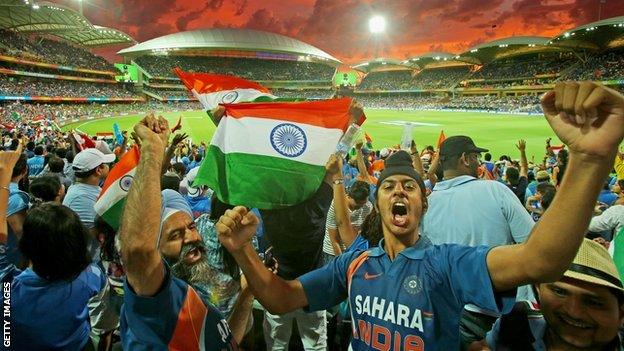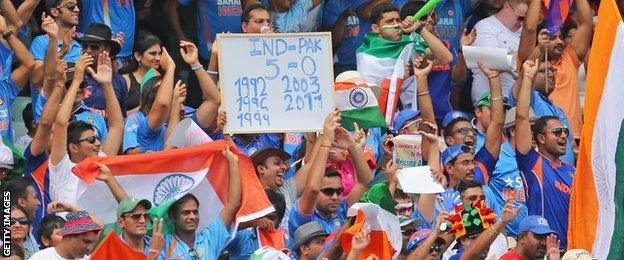Cricket World Cup 2015: India & Pakistan fans usurp the limelight
- Published

India fans enjoy the atmosphere in Adelaide
On the stairs in the top tier of the Riverbank Stand at the Adelaide Oval, beside a concrete wall, was a pink pram.
A young mother, dressed in the green of Pakistan, crouched to tend to her baby then jumped up to celebrate as India batsman Shikhar Dhawan was given run out.
In years to come she will be able to tell the child that they were at the cricket match which organisers claim was the most watched the world has ever seen.
The fiercest of rivalries and a lack of opportunities for these countries to compete against each other in sport creates a perfect storm for hype and anticipation.
When the rivalry is between India and Pakistan, a shared border and a shared love of cricket, historical tensions over politics and religion, a meeting on the first weekend of the World Cup was guaranteed to generate fervent excitement.
Tickets were said to be changing hands in the run-up for $750 on the black market.
India v Pakistan rivalry |
|---|
India and Pakistan became independent states in August 1947 |
The first Test series between the two teams took place in 1952, when Pakistan toured India, with India touring Pakistan for the first time in 1954-55. |
Between 1962 and 1977 inclusive, no cricket was played between the two countries because of two major wars in 1965 and 1971. |
The 1999 Kargil War and the 2008 Mumbai terror attacks, external also interrupted cricketing ties between the two nations. |
Since 2008, England and Australia have met in 20 Test matches, 38 ODIs and nine Twenty20s.India and Pakistan have contested only nine ODIs, four T20s and no Tests. |
The match was estimated to have attracted a global TV audience of over one billion. For every one person inside the ground, more than 200,000 were watching around the globe. The local newspaper was fully justified in its Sunday morning front-page headline "The Eyes of the World".
No room at the hotel? Try the airport
They travelled from all over the planet to be a part of it. Some 7,500 from India alone, but also from the UK, Singapore and even the United States. An estimated 35,000 visitors flocked to Adelaide, a city that only contains 26,000 hotel beds.
Every room within an hour radius was fully booked, the local airport putting up bed-less fans free of charge.
On a stiflingly hot Sunday morning, this part of South Australia was turned blue and green five hours before the first ball was bowled.
A day earlier, the walk to the Melbourne Cricket Ground for the Australia-England game felt more like a music festival than a sporting contest.
This was no different, except with an actual gig taking place, as India fans lined the steps outside the entrance to the Adelaide Oval to dance and sing.

India fans taunted their Pakistan counterparts with a reminder of their World Cup head-to-head record; Sunday's win was their sixth in as many match against their archrivals
Inside the ground, and from the distance of the press box, the assault on the eyes and ears was built on what we've come to expect at huge sporting occasions, only amplified.
Deafening noise at the toss when the stands were barely a quarter full, huge blocks of colour, roughly 90% blue. More flags than an Olympic opening ceremony, constant music played over the speakers, even during play.
But the delight was in the detail. Before the match, one pundit described it as "World War III". The reality was anything but.
In some sports, rivalry can mean abuse, hatred and even violence. India and Pakistan supporters proved that it need not mean hostility.
Fans mingled together, dancing to the beat of the same drum, exchanging songs and good-natured banter.
It was an occasion for families. Our friend in the pink pram was not the only one too young to realise what was going on. Indeed, the amount of strollers, buggies and pushchairs must have created some sort of record.
Cheering together

Pakistan supporters are hoping for a repeat of the team's 1992 World Cup success
Overall, there was a great sense of freedom, an outpouring of joy just to be there, regardless of the action on the pitch, best demonstrated by the fall of the first wicket of the day. When India batsman Rohit Sharma was dismissed, the big screen showed a Pakistan and India fan both cheering together.
And, these guys know how to have a good time. The Barmy Army think they like a song, but they've got nothing on the India fans.
There's no choreography, no co-ordination, just pockets of supporters doing their own thing. You think you're in the best spot, but then see something else that looks more fun, like being at a house party and not knowing which room to stay in.
One of the great spectacles
In his book Fever Pitch, Nick Hornby explains that top football clubs would like to have their stadiums full of corporate boxes, because that would generate more revenue.
However, the reason they don't is because it is the ordinary supporter that creates the spectacle. How dull would a Premier League football match, a Six Nations game, or a Las Vegas fight be if they were played out in front of an empty house?
Not so in Adelaide, where the spectators stole the show.
The match itself struggled to live up to the hype as India beat their bitter rivals by a comprehensive 76 runs.
But the passion, colour, noise, and good nature of the two sets of supporters created one of the great spectacles in sport.
- Published15 February 2015

- Published15 February 2015

- Published15 February 2015

- Published30 July 2013

- Published15 May 2018

- Published18 October 2019
